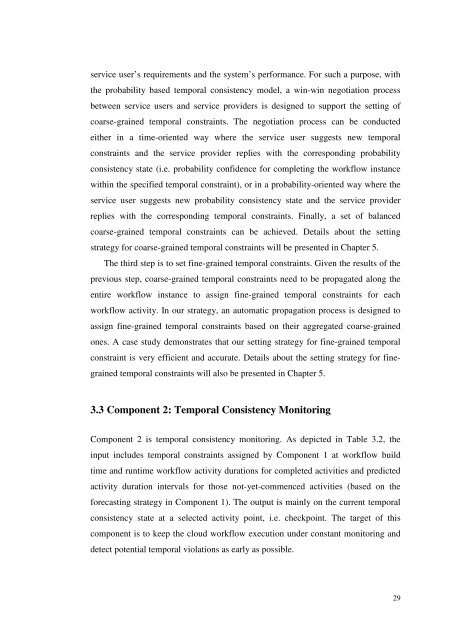Xiao Liu PhD Thesis.pdf - Faculty of Information and Communication ...
Xiao Liu PhD Thesis.pdf - Faculty of Information and Communication ...
Xiao Liu PhD Thesis.pdf - Faculty of Information and Communication ...
Create successful ePaper yourself
Turn your PDF publications into a flip-book with our unique Google optimized e-Paper software.
service user’s requirements <strong>and</strong> the system’s performance. For such a purpose, with<br />
the probability based temporal consistency model, a win-win negotiation process<br />
between service users <strong>and</strong> service providers is designed to support the setting <strong>of</strong><br />
coarse-grained temporal constraints. The negotiation process can be conducted<br />
either in a time-oriented way where the service user suggests new temporal<br />
constraints <strong>and</strong> the service provider replies with the corresponding probability<br />
consistency state (i.e. probability confidence for completing the workflow instance<br />
within the specified temporal constraint), or in a probability-oriented way where the<br />
service user suggests new probability consistency state <strong>and</strong> the service provider<br />
replies with the corresponding temporal constraints. Finally, a set <strong>of</strong> balanced<br />
coarse-grained temporal constraints can be achieved. Details about the setting<br />
strategy for coarse-grained temporal constraints will be presented in Chapter 5.<br />
The third step is to set fine-grained temporal constraints. Given the results <strong>of</strong> the<br />
previous step, coarse-grained temporal constraints need to be propagated along the<br />
entire workflow instance to assign fine-grained temporal constraints for each<br />
workflow activity. In our strategy, an automatic propagation process is designed to<br />
assign fine-grained temporal constraints based on their aggregated coarse-grained<br />
ones. A case study demonstrates that our setting strategy for fine-grained temporal<br />
constraint is very efficient <strong>and</strong> accurate. Details about the setting strategy for finegrained<br />
temporal constraints will also be presented in Chapter 5.<br />
3.3 Component 2: Temporal Consistency Monitoring<br />
Component 2 is temporal consistency monitoring. As depicted in Table 3.2, the<br />
input includes temporal constraints assigned by Component 1 at workflow build<br />
time <strong>and</strong> runtime workflow activity durations for completed activities <strong>and</strong> predicted<br />
activity duration intervals for those not-yet-commenced activities (based on the<br />
forecasting strategy in Component 1). The output is mainly on the current temporal<br />
consistency state at a selected activity point, i.e. checkpoint. The target <strong>of</strong> this<br />
component is to keep the cloud workflow execution under constant monitoring <strong>and</strong><br />
detect potential temporal violations as early as possible.<br />
29
















